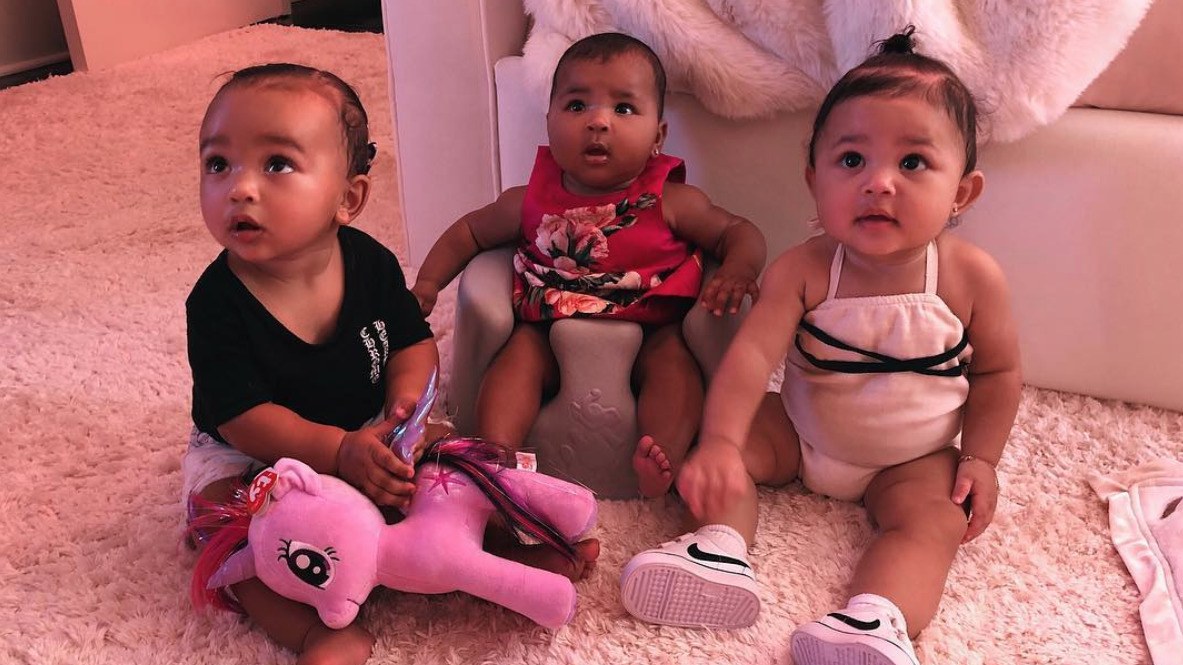Khloé Kardashian Shouldn't Have to 'Block Out' Racist Remarks About True

If you’ve spent any time on the Internet in the past week, you’ve likely seen the photo Kim Kardashian West shared of she and her sisters’ “triplets”: infant cousins Stormi Webster, True Thompson, and Chicago West. What should have been a sweet family moment—it was the first time all three infants have been pictured together—immediately derailed into a conversation about the toxic effects of colorism.
Not even minutes after the photo went up, commenters flocked to the image to critique and rate how the babies—babies!—looked. Or, more specifically, to share their discontent over the fact that True lacks the stereotypical biracial characteristics her cousins possess. The consistent underlying thread: She’s cute but “too dark.”
Khloé eventually closed comments on the photo to block her family from the racist abuse. And this morning, she took to Twitter to respond, assuring fans and haters that she was “blocking out the white noise.”
https://twitter.com/khloekardashian/status/1042207425175072769
https://twitter.com/khloekardashian/status/1042634486943375360
https://twitter.com/khloekardashian/status/1042633868224819201
Although vile, the issue here is not solely about sexualizing, projecting and critiquing the desirability of a five-month-old baby, but the perpetuation of colorism. Even though Khloé’s wealth will insulate True, the fact is that her darker skin tone will be a factor in most of her interactions for the rest of her life—with school, with jobs, with dating, and with the value society places on her.
Colorism is nothing new; the 300-plus year experiences of darker-hued people around the world didn’t have a name until author Alice Walker coined the term in her 1983 book of essays, In Search of Our Mothers’ Gardens. In the book, she explicitly defines colorism as “prejudicial or preferential treatment of same-race people based solely on their color.” (Historically speaking, lighter skin was a currency used to gain social status and class progression, and in times of enslavement, freedom.) In layman’s terms: the lighter a person of a non-white race is, the better they’re perceived and treated.
Today, colorism is still particularly insidious in film, fashion, and beauty—industries predicated on appearances. From pay disparities between models and actresses to being completely cast aside for possessing broad African features, women of color who fall on the lighter end of the spectrum are afforded more opportunities.
As a model, I’ve been on countless sets where I’m the only black person, yet the shoot is supposed to be about diversity. I’ve been told that I don’t fall within the borders of an “all-American aesthetic.” And I’ve been interrogated multiple times about my race at castings. Even still, I’m a fair-skinned black woman with freckles and looser curls. So I understand how my privilege allows me to move and show up in spaces where models that look like Duckie Thot and Leomie Anderson have not been able to access. (Both the Fenty Beauty star and Victoria’s Secret model have talked at length about the fact that light-skinned women of color get more work than dark-skinned models.)
In Hollywood, lighter actresses such as Amandla Stenberg, Yara Shahidi, and Tessa Thompson usually fare better with role diversity than women like Viola Davis or Octavia Spencer. Spencer, an Oscar winner, just recently shared that she had to have her contract tied to actress Jessica Chastain’s in order to make five times her normal salary.
Even in outside industries, studies show that white employers are more likely to view lighter candidates as more qualified than their darker peers, creating a wage gap that goes deeper that just race and/or gender. Darker women of color lack wealth just from skin color alone regardless of educational background or achievement.
This, of course, in no way dismisses the ways white people themselves fall victim to their own beauty standards. Khloe Kardashian, who’s faced public vitriol for being the “ugly one” because never held the softer, whiter features of her sisters, has augmented her appearance to ascend to the level of mainstream beauty her sisters have attained—like getting fillers, for example. Even still, it seems fans fans neglected to consider both she and Tristan Thompson’s features and assumed True would be born in the likeness of her older cousins.
What people need to understand is that black people, multiracial or otherwise, come in a gradient of shades and tones. Mixed-race children are not always born with lighter skin, hazel eyes, or loose, sprightly curls. They should be loved and protected—period—and allowed the ability to embrace their full selves without being socialized into resenting a part of themselves that is rich in history and culture.
Related Stories:
–Meghan Markle Reveals What It’s Like to Be a Biracial Woman in Hollywood
–Makeup for Melanin Girls Isn’t Just Making Products for Women of Color. It’s Listening to Them.
–Khoudia Diop: I Want to Show Women It’s Not ‘Bad’ to Be Dark